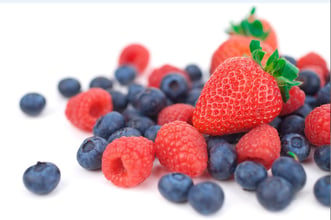 It’s no secret that eating fruits and vegetables is important to a healthy diet. Studies show that eating high levels of produce is associated with lower risks of chronic diseases, including heart disease, high blood pressure, diabetes and obesity. It’s probably no secret either that Americans don’t eat enough fruits and vegetables. In the March 2014 issue of the Journal of Epidemiology and Community Health researchers found that 80 percent of Americans don’t eat the daily recommend 1.5 to 2.5 cups of fruit while 90 percent don’t eat the daily recommended 2-3.5 cups of vegetables. . In other words, we are a long way off from where we need to be.
It’s no secret that eating fruits and vegetables is important to a healthy diet. Studies show that eating high levels of produce is associated with lower risks of chronic diseases, including heart disease, high blood pressure, diabetes and obesity. It’s probably no secret either that Americans don’t eat enough fruits and vegetables. In the March 2014 issue of the Journal of Epidemiology and Community Health researchers found that 80 percent of Americans don’t eat the daily recommend 1.5 to 2.5 cups of fruit while 90 percent don’t eat the daily recommended 2-3.5 cups of vegetables. . In other words, we are a long way off from where we need to be.
So why are we talking about eating more fruits and vegetables?
A Consumer Reports survey in November 2014 found that 85 percent of Americans are concerned about pesticide exposure in food. Consumer Reports reviewed 12 years of data from the U.S. Department of Agriculture and categorized 48 different foods in to varying risk categories, from very low to very high. They level of risk was based on the risk to a 3-year-old. While the USDA’s Pesticide Data Program has always stated that U.S. food does not post safety concerns for pesticide residues, “Consumer Reports pointed out that multiple pesticides are often found on samples. The tolerance levels are set for individual pesticides, but the effects of these pesticide combinations are untested and unknown.”[i]
Based on is research, Consumer Reports suggests “the best way to maximize the nutritional benefit from fruits and vegetables while minimizing the negative effects of pesticides on the health of the environment, workers, and yourself is to buy organic.”[ii]
In its March 2015 report “From Crop to Table,” Consumer Reports suggest that consumers should always select organic options for cranberries, nectarines, peaches, strawberries, tangerines, as well as carrots, green beans, hot peppers, sweet bell peppers and sweet potatoes. These items were found to be low or very low-risk for pesticide residues.
Knowing that organic produce is more expensive, Consumer Reports listed conventionally grown produce, bananas, broccoli, cherries, lettuce, onions and oranges were in the low to very-low risk categories.
Among the notable facts[iii] detailed in Consumer Reports “From Crop to Table,” report were the following:
- Farmers use almost 700 pounds of pesticide each year
- U.S. Geological survey found neonicotinoid insecticides in water samples of all of nine streams tested in the Midwest
- Researchers have found the herbicide glyphosate in 60-100 percent of air and rain samples in Iowa and Mississippi
- The Centers for Disease Controls has found 29 different pesticide metabolites are present in most Americans
- The herbicide 2,4-D has been found in vacuum cleaner dust samples in 95 percent of homes near Iowa farms
While the threat of pesticides are real, Consumer Reports does not give consumers a bye on eating their fruits and vegetables.
Urvashi Rangan, Ph.D., a toxicologist and executive director of the Consumer Reports Food Safety and Sustainability Center, said, “your primary goal is to eat a diet rich in fruits and vegetables—ideally five or more servings a day—even if it’s a type that falls into our very high-risk category.”[1]
Teledyne Tekmar’s AutoMate-Q40 is used for sample preparation in the analysis of pesticide residues. For more information on the AutoMate-Q40 Automated QuEChERS Sample Prep System, visit our website http://www.teledynetekmar.com/AutoMateQ40/ or click the button below
Note: In a previous blog titled, “Are “Green Products Killing Us?,” we referenced the challenge with cleaning products and personal care products labeled as “organic.” Labeling for these products are fundamentally different than food products with the “organic” label. The USDA considers the organic products as “products produced under the authority of the Organic Foods Production Act. The principal guidelines for organic production are to use materials and practices that enhance the ecological balance of natural systems and that integrate the parts of the farming system into an ecological whole.” For more information on organic food labeling, visit http://www.nal.usda.gov/afsic/pubs/ofp/ofp.shtml
[1] http://www.consumerreports.org/cro/magazine/2015/05/pesticides-in-produce/index.htm
[i] http://www.foodsafetynews.com/2015/03/consumer-reports-guides-shoppers-through-produce-pesticide-residues/#.VRLuaUZnBVS
[ii] “From Crop to Table, http://www.consumerreports.org/content/dam/cro/magazine-articles/2015/May/Consumer%20Reports_From%20Crop%20to%20Table%20Report_March%202015.pdf, pg 2.
[iii] Ibid, pg. 4
